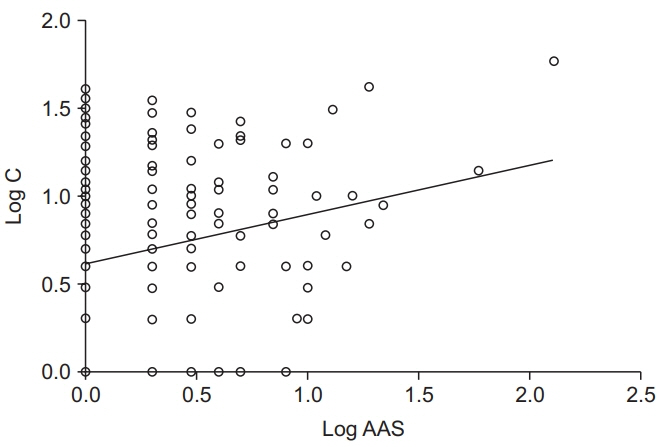Ann Rehabil Med.
2020 Apr;44(2):158-164. 10.5535/arm.2020.44.2.158.
A Bibliometric Analysis Using Alternative Metrics for Articles in the Annals of Rehabilitation Medicine
- Affiliations
-
- 1Department of Physical Medicine and Rehabilitation, Veterans Health Service Medical Center, Seoul, Korea
- KMID: 2501060
- DOI: http://doi.org/10.5535/arm.2020.44.2.158
Abstract
Objective
To investigate the articles in the Annals of Rehabilitation Medicine (ARM) using a bibliometric analysis to verify whether there is a correlation between the topics of interest for expert groups and the public media.
Methods
A total of 1,088 ARM articles from the third issue of 2011 to the third issue of 2019 were analyzed. We conducted a bibliometric analysis of the articles using conventional metrics (CM) and alternative metrics (AM). The CM was investigated by collating the type of publication, number of citations, and the specific field of rehabilitation medicine for each article. The AM was analyzed using the Altmetric Attention Score (AAS) provided by Altmetric, the leading AM company. The correlation between the number of citations and the AAS was tested using the Spearman rank correlation coefficient.
Results
The combined ratio of original articles and case reports was over 90% in this study; however, the total distribution was significantly different compared to previous bibliometric studies (p<0.05). There were 233 articles that satisfied both conditions of at least one citation and at least one AAS point. The number of citations and the AAS were found to have a statistically significant positive linear correlation on a scatter plot (r=0.216, p=0.001).
Conclusion
There is a significant correlation between AM and CM, which means itis important to increase the dissemination of academic knowledge through the public media and increase the status of the journal by increasing the citation-related index.
Figure
Reference
-
1. Bonciu C. Title, abstract and keywords: essential issues in medical bibliographic research. Rev Med Chir Soc Med Nat Iasi. 2005; 109:916–26.2. Cooper ID. Bibliometrics basics. J Med Libr Assoc. 2015; 103:217–8.
Article3. Mathur VP, Sharma A. Impact factor and other standardized measures of journal citation: a perspective. Indian J Dent Res. 2009; 20:81–5.
Article4. Baheti AD, Bhargava P. Altmetrics: a measure of social attention toward scientific research. Curr Probl Diagn Radiol. 2017; 46:391–2.
Article5. Zahedi Z, Costas R. General discussion of data quality challenges in social media metrics: extensive comparison of four major altmetric data aggregators. PLoS One. 2018; 13:e0197326.
Article6. Araujo R, Sorensen AA, Konkiel S, Bloem BR. Top altmetric scores in the Parkinson’s disease literature. J Parkinsons Dis. 2017; 7:81–7.7. Kim ES, Yoon DY, Kim HJ, Lee K, Kim Y, Bae JS, et al. The most mentioned neuroimaging articles in online media: a bibliometric analysis of the top 100 articles with the highest Altmetric Attention Scores. Acta Radiol. 2019; 60:1680–6.
Article8. Kim HJ, Yoon DY, Kim ES, Yun EJ, Jeon HJ, Lee JY, et al. The most mentioned neurointervention articles in online media: a bibliometric analysis of the top 101 articles with the highest altmetric attention scores. J Neurointerv Surg. 2019; 11:528–32.
Article9. Marincek C, Franchignoni F. Some thoughts on bibliometrics, usage metrics and altmetrics concerning the International Journal of Rehabilitation Research. Int J Rehabil Res. 2019; 42:193–5.
Article10. Niehaus WN, Silver JK, Katz MS. The PM&R Journal implements a social media strategy to disseminate research and track alternative metrics in physical medicine and rehabilitation. PM R. 2018; 10:538–43.11. Knowlton SE, Paganoni S, Niehaus W, Verduzco-Gutierrez M, Sharma R, Iaccarino MA, et al. Measuring the impact of research using conventional and alternative metrics. Am J Phys Med Rehabil. 2019; 98:331–8.
Article12. Huh S. The elevation of Annals of Rehabilitation Medicine to the status of an international journal after adopting an English-only policy. Ann Rehabil Med. 2015; 39:661–6.13. Lee YH, Jun Sung Park JS, Yi TI, Shin JC. A study of overall compositions and yearly trend of the Journal of Korean Academy of Rehabilitation Medicine for calender years 1977 through 1993. J Korean Acad Rehabil Med. 1995; 19:417–24.14. Kim JH, Kim JS. Statistical methods used in the Journal of Korean Academy of Rehabilitation Medicine. J Korean Acad Rehabil Med. 1998; 22:46–55.15. Kim J, Yoon S, Kang JJ, Han K, Kim JM, Kim SK. Research designs and statistical methods trends in the Annals of Rehabilitation Medicine. Ann Rehabil Med. 2017; 41:475–82.
Article16. Lim JK, Han JY, Lee HC, Lee J, Chung H, Kim JM, et al. Analysis of publication status of abstracts presented at the annual meeting of the Korean academy of rehabilitation medicine. Ann Rehabil Med. 2013; 37:413–9.
Article17. Korean Academy of Rehabilitation Medicine [Internet]. Seoul, Korea: Korean Academy of Rehabilitation Medicine;2018. [cited 2020 Mar 15]. Available from: https://www.karm.or.kr/bbs/index.html?code=notice&category=&gubun=&page=7&number=14679&mode=view&keyfield=&key=.18. Seglen PO. Why the impact factor of journals should not be used for evaluating research. BMJ. 1997; 314:498–502.
Article19. Kumar A. Is “Impact” the “Factor” that matters…? (Part I). J Indian Soc Periodontol. 2018; 22:95–6.
Article
- Full Text Links
- Actions
-
Cited
- CITED
-
- Close
- Share
- Similar articles
-
- Bibliometric and Altmetric Analyses of Publication Activity in the Field of Behcet's Disease in 2010–2019
- Contemporary research trends on nanoparticles in endodontics: a bibliometric and scientometric analysis of the top 100 most-cited articles
- Understanding anterior communicating artery aneurysms: A bibliometric analysis of top 100 most cited articles
- Journal metrics, document network, and conceptual and social structures of the Korean Journal of Anesthesiology from 2017 to July 2022: a bibliometric study
- The most influential articles on kidney transplantation: a bibliometric and visualized analysis



